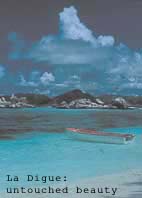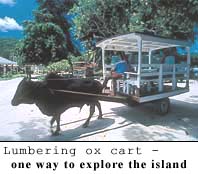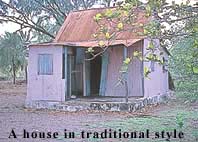 Tranquility
tinged with drama Tranquility
tinged with drama
 LA
DIGUE, SEYCHELLES: The rosy- cheeked Rastafarian, his sun- streaked hair
hanging down his back in braids, handed me a bicycle. A tender had landed
myself and other ship's passengers at the spot where, 200 years before,
20 political prisoners from Reunion disembarked to set up the first settlement
on the island of La Digue. LA
DIGUE, SEYCHELLES: The rosy- cheeked Rastafarian, his sun- streaked hair
hanging down his back in braids, handed me a bicycle. A tender had landed
myself and other ship's passengers at the spot where, 200 years before,
20 political prisoners from Reunion disembarked to set up the first settlement
on the island of La Digue.
The youth with his Rastafarian hairstyle and Breton complexion, could
have descended from one of those French exiles and an African slave. The
people of La Digue reveal their mixed ancestry in bright blue eyes set
in swarthy, pirate- like features, and in the dark, radiant beauty complementing
the lithesome figures of the island's maidens. It's easy to wax lyrical
about La Digue; it has an easy- going people and a simple, countryside
charm that makes it the prettiest port of call in the Indian Ocean.
The island is small, with only 2,000 inhabitants, and is regarded as
the most exquisite and untouched of all the beautiful islands in the Seychelles.
A popular island for cruise liners to visit, it can also be reached by
schooner from neighbouring Praslin island, a journey of about 30 minutes.
It is a tranquil paradise, a granitic island protected by an encircling
reef. The contrasting colours of the azure sea, vibrant green vegetation
and brilliant white sand, dotted with amazing pink rock formations, contribute
to a dramatic holiday location.
 There
are three ways to explore the island. The most popular is by bicycle which
can be hired at the jetty from an amiable bunch of lads whose English is
splattered with guttural Creole ribaldry. A bicycle costs the equivalent
of 300 rupees for half a day. Long enough. It takes only an hour to cycle
all the trails and return to the jetty. Walking would take a couple of
hours. The third option for exploration is a lumbering ox-cart with pneumatic
tyres, and that takes much longer. There
are three ways to explore the island. The most popular is by bicycle which
can be hired at the jetty from an amiable bunch of lads whose English is
splattered with guttural Creole ribaldry. A bicycle costs the equivalent
of 300 rupees for half a day. Long enough. It takes only an hour to cycle
all the trails and return to the jetty. Walking would take a couple of
hours. The third option for exploration is a lumbering ox-cart with pneumatic
tyres, and that takes much longer.
The main trail leads past the fish market where local fishermen sell
a catch that includes jack, tuna, mackerel, parrot fish, grouper, snapper
and octopus - a favourite dish of the Seychellois. The trail runs along
the beach, passing under large takamaka (Ceyllophyllum inophyllum) trees.
Takamaka used to cover the flat areas of La Digue and the tree's fine red
timber is used for building boats and houses.
A small hospital, named after Sir Marston Logan, British governor of
the Seychelles from 1942 to 1947, commands a view of the bay.
Gone now is the factory next to it which produced banana flour from
dried green bananas, exported to Europe in quantity in the 1930s.
Copra and vanilla were also produced on La Digue. Cultivated vanilla
was a major crop on the island in the 19th century. It was destroyed early
this century by a combination of drought, devastating disease and ultimately
competition form synthetic vanillin. It has been revived on a small scale
in La Digue; it is dedicated work since vanilla is a type of orchid that
has to be grown on a support tree and be hand pollinated.
A few pretty houses in traditional style, thatched wooden cottages masquerading
as cute mansions, remain tucked away behind bright bougainvillea. A surprise
is to discover a modern supermarket opposite a hotel complex, and a branch
of the very- British Barclays Bank.
A map of La Digue is highlighted with captions like "copra dryer"
"giant tortoise pen". "mangrove swamp," "duck
farm," and "waterlily dam." The bird lover thrills to the
short walk through the "Paradise Flycatcher Nature Reserve."
The Seychelles Black Paradise Flycatcher (Terpsiphone corvina) is found
only in La Digue. The male flashes by with iridescent black feathers and
a long tail streaming behind. Its plumage has earned it the Creole name
"Vev", meaning 'widow'. The birds live mainly in this shady,
protected woodland forest of Takamaka and Indian almond.
While there are modern buildings offering hotel accommodation secluded
along the coast, the most unusual place to stay in the Seychelles is to
be found in the interior of La Digue. Chateau St Cloud was built at the
height of Napoleon's empire and is named after the small French town of
St Cloud, south of Paris. The chateau was once part of a vanilla farm and
the old factory remains.
Converted now to a 10-room hotel, the chateau is run by descendants
of the original owners, the St Ange family. They have retained the ambience
of the French colonial period. The original floor of the main building
is still held down with hand made nails, and the rooms are furnished with
rustic antiques. In the former slave quarters, the chains to shackle the
estate's slaves to the walls are a poignant reminder of the past.
 Guests
at the chateau are treated like the owner's friends, invited to stay in
a traditional family home. There is one dining table shared by all, for
meals prepared with Creole flair in old copper pots by Madam St Ange herself. Guests
at the chateau are treated like the owner's friends, invited to stay in
a traditional family home. There is one dining table shared by all, for
meals prepared with Creole flair in old copper pots by Madam St Ange herself.
The chateau is the perfect place to stay when you want to lose yourself
in an island of exotic flowers and birds, where the coco-de-mer grows wild
and the only sounds are the rustle of giant tortoises ambling through the
undergrowth and the bicycle bell of other visitors discovering one of nature's
few remaining secrets: the dignified tranquility that is La Digue.
Travel notes: Rooms at the Chateau St Cloud (Tel/fax 248 234 346)
start at about SLRs 6,250 for a double, with breakfast and dinner. There
is a weekly flight form Dubai to the Seychelles which connects with flights
by AirLanka and Emirates from Colombo. From the Mahe airport there are
15-minute flights to Praslin from where a schooner sails five times a day
to La Digue. A long journey, but it's worth it.
|







